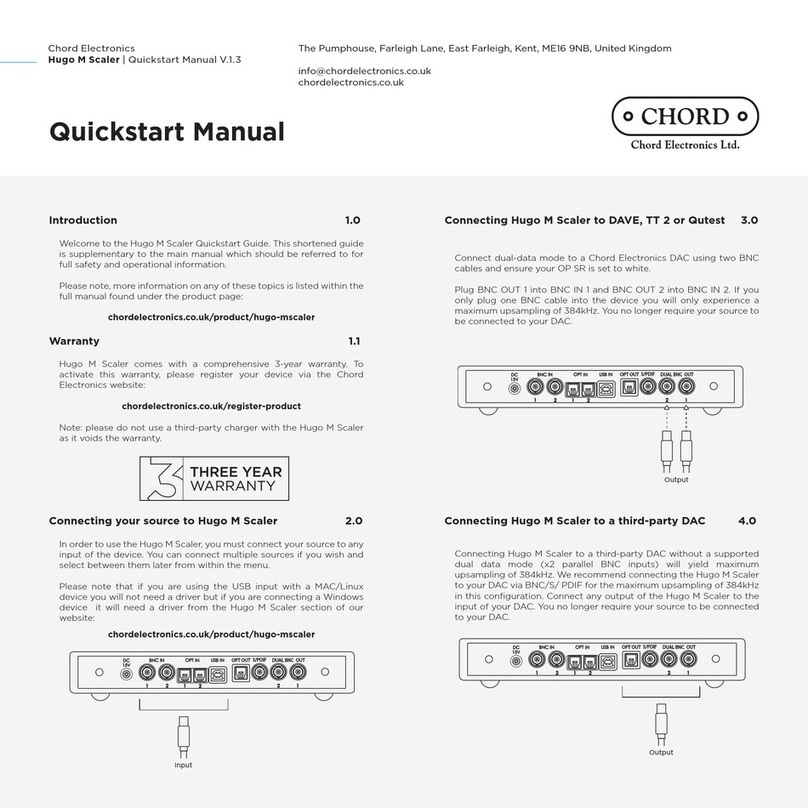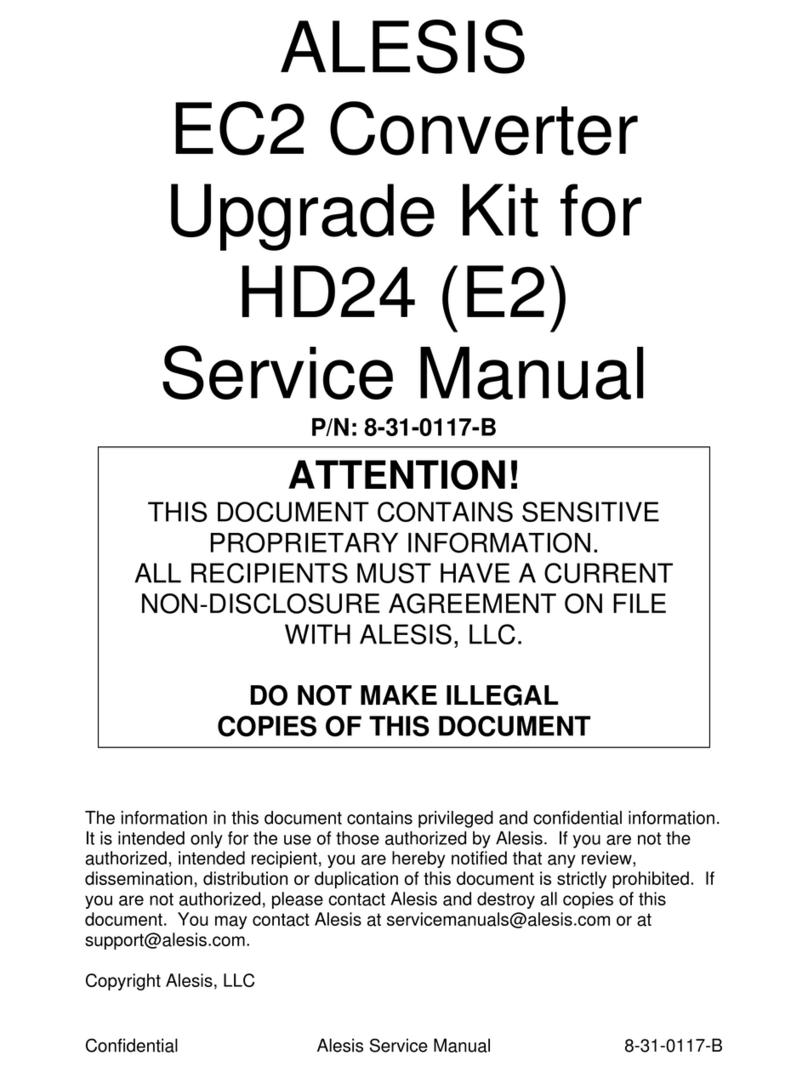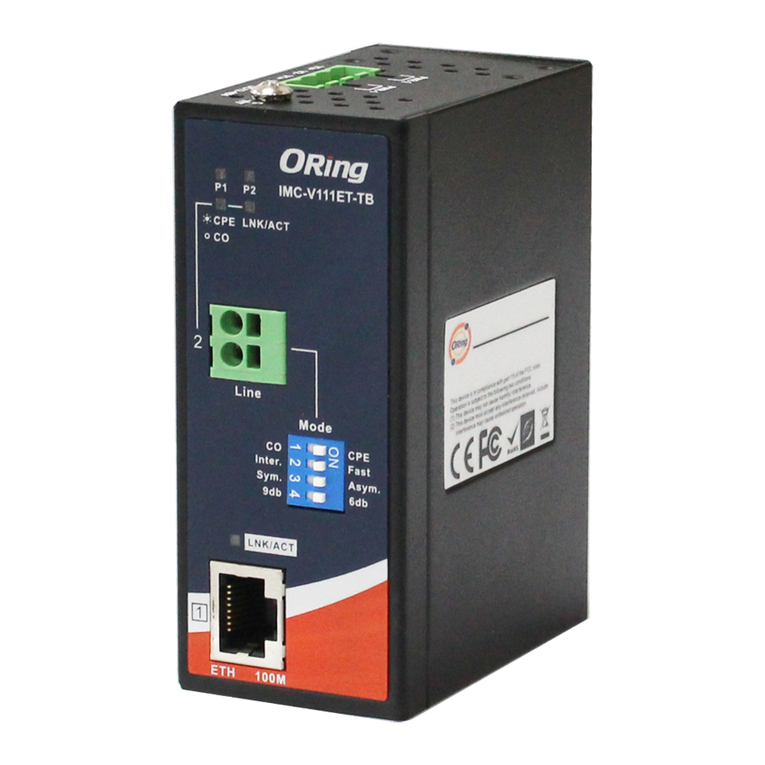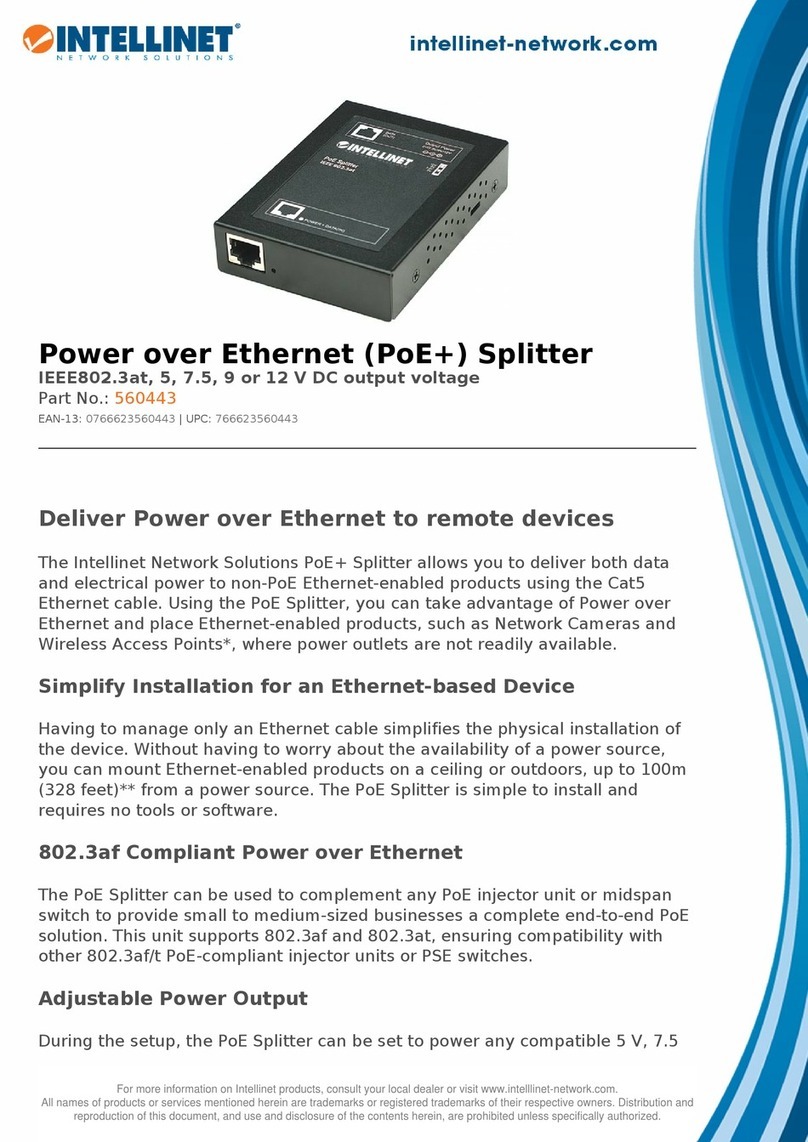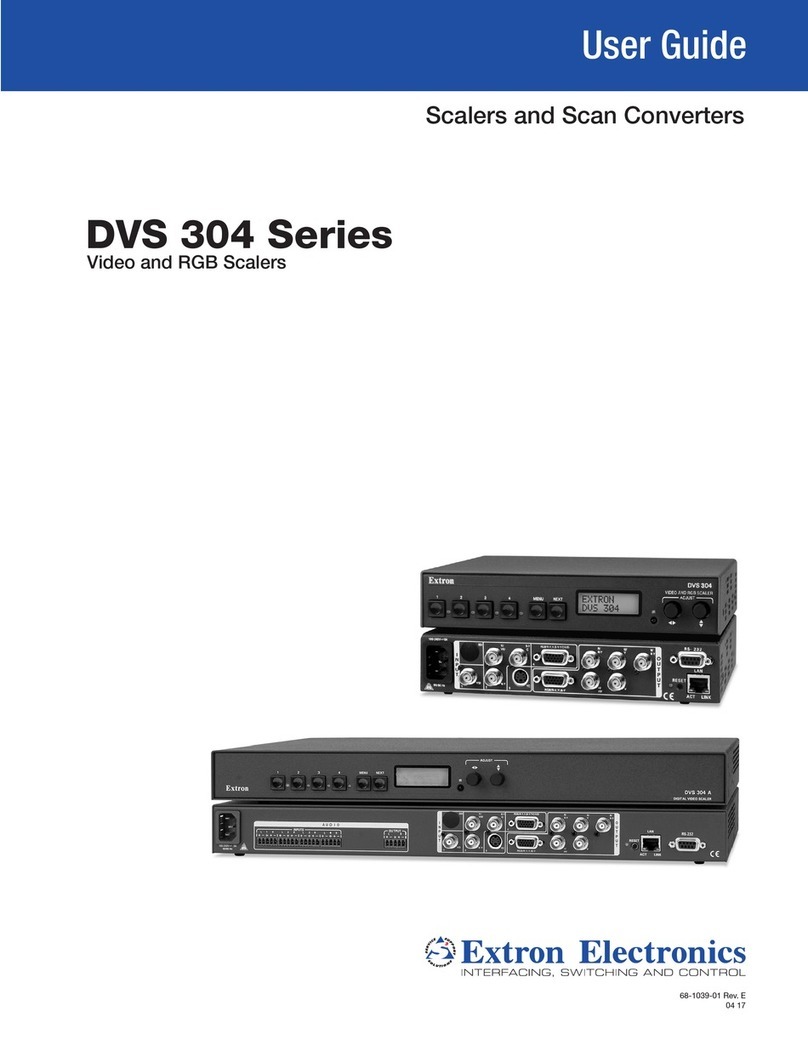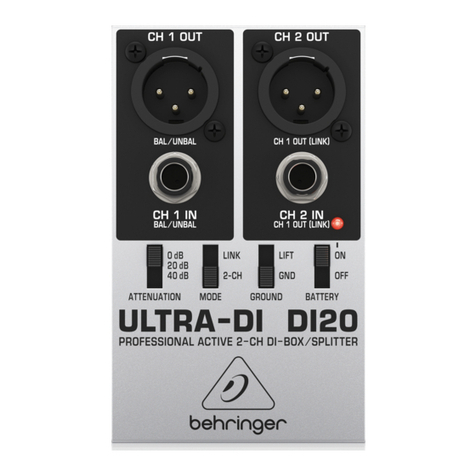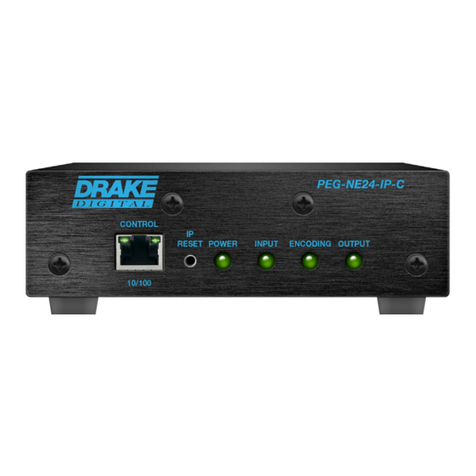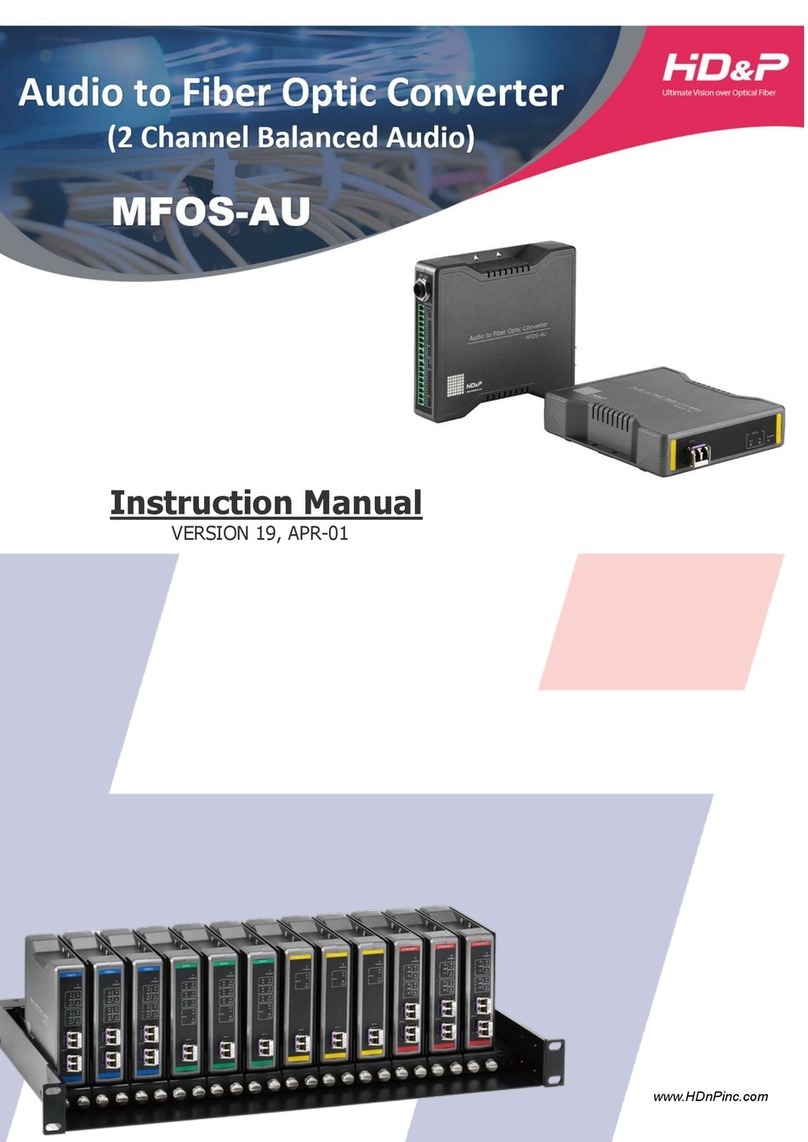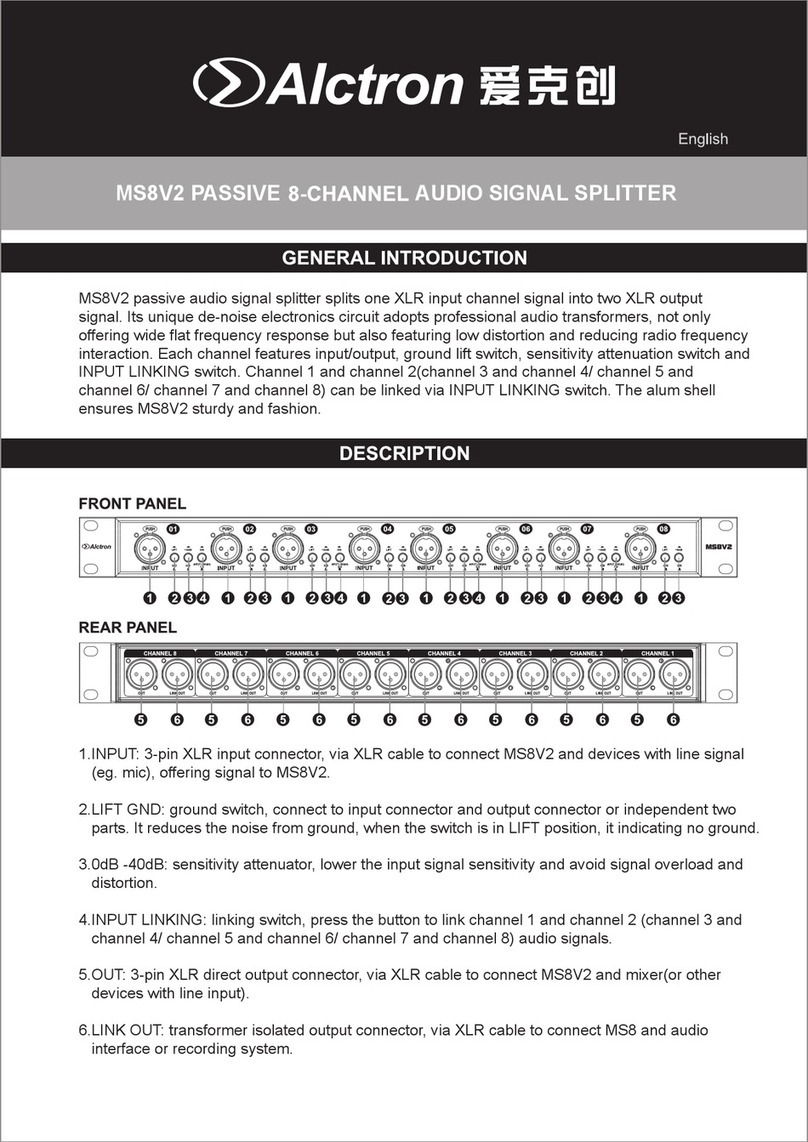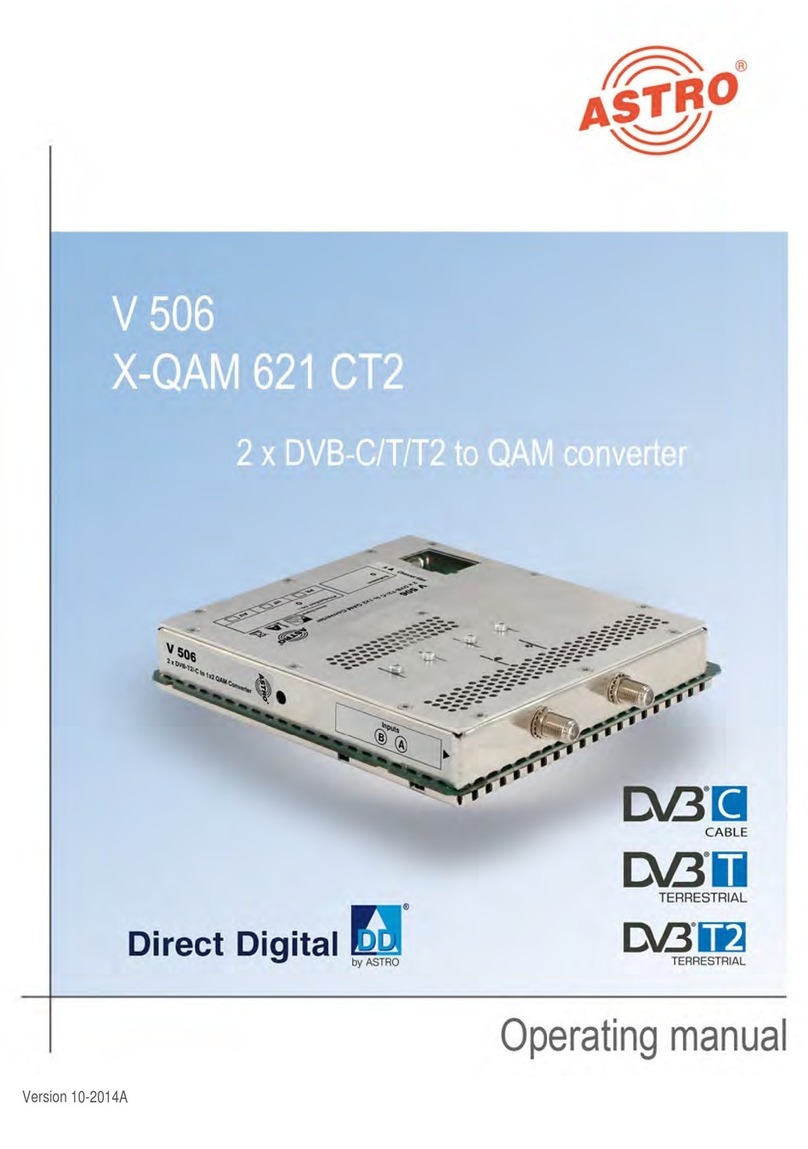FiberLabs Dexin NDS3561C User manual

NDS356xC SD IRD User’s Manual
Web-NMS Version: 1.10
Software: 2.18
Hardware: 2.00
Chengdu Dexin Digital Technology Co., Ltd.

2 / 41
About This Manual
Intended Audience
This user manual has been written to help people who have to use, to integrate and to install the
product. Some chapters require some prerequisite knowledge in electronics and especially in
broadcast technologies and standards.
Disclaimer
No part of this document may be reproduced in any form without the written permission of the
copyright owner.
The contents of this document are subject to revision without notice due to continued progress in
methodology, design and manufacturing. DEXIN shall have no liability for any error or damage
of any kind resulting from the use of this document.
Copy Warning
This document includes some confidential information. Its usage is limited to the owners of the
product that it is relevant to. It cannot be copied, modified, or translated in another language
without prior written authorization from DEXIN.

3 / 41
DIRECTORY
Chapter 1 Product Outline ...........................................................................................4
1.1 Outline ....................................................................................................................4
1.2 Features...................................................................................................................4
1.3 Specifications...........................................................................................................4
1.4 Principle Chart .........................................................................................................5
1.5 Appearance and description.......................................................................................6
Chapter 2 Installation Guide ........................................................................................7
2.1 Acquisition Check ....................................................................................................7
2.2 Installation Preparation .............................................................................................7
2.3 Wire‟s Connection....................................................................................................9
2.4 Signal Cable Connection ...........................................................................................9
Chapter 3 Operation ..................................................................................................11
3.1 LCD Menu Class Tree ............................................................................................11
3.2 General Setting.......................................................................................................14
Chapter 4 Web-based NMS Management ...................................................................25
4.1 login......................................................................................................................25
4.2 Operation...............................................................................................................25
Chapter 5 Troubleshooting.........................................................................................40
Chapter 6 Packing List...............................................................................................41

4 / 41
Chapter 1 Product Outline
1.1 Outline
NDS356xC SD IRD is DEXIN‟s all-in-one device which integrates demodulation, de-scrambling
and decoding in one case to convert RF signals (DVB-C, T/T2, S/S2 optional) into analogue
video (CVBS) output.
It is a 1-U case which supports 2 tuner inputs. The two CAMs/CIs accompanied can descramble
the programs input from encrypted RF, ASI and IP. The CAM requires NO unsightly external
power cords, cables, or additional remote control device.
Its pluggable structure design greatly facilitates the change of modules (demodulator or decoder)
as needed.
To meet customers‟various requirements, NDS356xC is also equipped with ASI and IP input,
and output with 2 ASI ports and IP port.
1.2 Features
Demodulation + descrambler + decoder modules in one box
2 Tuner inputs (DVB-C, T/T2, S/S2 Optional)
1 ASI & 1 IP (UDP) input for re-mux
One CAM can decrypt multiple programs from Tuners/ASI/IP
Separate 4*CVBS video output
IP (1 MPTS & 8 SPTS) over UDP and RTP/RTSP output; ASI out
Support maximum 128 PID mapping per input
Pluggable and changeable demodulator and decoder modules
Support BISS descrambling (Up to 120Mbps)
LCD display, Remote control and Firmware, web NMS management
Updates via web
Best quality and breakthrough price

NDS356xC SD IRD User‟s Manual
5 / 41
1.3 Specifications
Input
2 x RF (DVB-C, T/T2, S/S2 optional), F type
1×ASI input for re-mux, BNC interface
1xIP input for re-mux (UDP)
Tuner Section
DVB-C
Standard
J.83A(DVB-C), J.83B, J.83C
Input Frequency
47 MHz~860 MHz
Constellation
16/32/64/128/256 QAM
DVB-T/T2
Input Frequency
44MHz ~1002 MHz
Bandwidth
6/7/8 M bandwidth
DVB-S
Input Frequency
950-2150MHz
Symbol rate
2-45Msps
Signal Strength
- 65- -25dBm
Constellation
1/2, 2/3, 3/4, 5/6, 7/8 QPSK
DVB-S2
Input Frequency
950-2150MHz
Symbol rate
QPSK 1~45Mbauds;
8PSK 2~30Mbauds
Code rate
1/2, 3/5, 2/3, 3/4, 4/5, 5/6,
8/9, 9/10
Constellation
QPSK, 8PSK
Output (4*CVBS optional)
IP
Output
1*MPTS & 8*SPTS over UDP, RTP/RTSP.
100Base-T Ethernet interface (unicast /
multicast)
2×ASI
BNC interface
Decode
Output
Video Interface: 4xCVBS (RCA)
Audio Interface: 4xStereo/8xMono
(RCA)
Resolution: PAL 576i, NTSC 480i
Video Decode: MPEG-2, MPEG-4
AVC/H.264
Audio Decode: MPEG 1 Layer II
System
Local interface
LCD + control buttons
Remote management
Web NMS Management
Language
English
General
Power supply
AC 100V~240V
Dimensions
482*300*44.5mm
Weight
3 kgs
Operation temperature
0~45℃
1.4 Principle Chart

NDS356xC SD IRD User‟s Manual
6 / 41
1.5 Appearance and description
Front Panel Illustration:
1
LCD Display
2
NMS Port (for PC connection)
3
DATA Port (for IP stream input & output)
4
Indicators Area
5
Up/Down/Left/Right Buttons
Enter Key
Menu Key
Lock Key
Rear Panel Illustration
1
Decoder Module (for A/V output)
2
Demodulation & Descrambler Module (for RF signal input and CAMs
/Smart cards insertion)
3
ASI input Port for re-mux
4
ASI output Ports
5
Power switch/Fuse/Socket
6
Grounding Wire

NDS356xC SD IRD User‟s Manual
7 / 41
Chapter 2 Installation Guide
2.1 Acquisition Check
When user opens the package of the device, it is necessary to check items according to
packing list. Normally it should include the following items:
NDS356xC SD IRD 1pcs
User‟s Manual 1pcs
ASI Cable 1pcs
Power Cord 1pcs
If any item is missing or mismatching with the list above, please contact our company.
2.2 Installation Preparation
When users install device, please follow the below steps. The details of installation will be
described at the rest part of this chapter. Users can also refer rear panel chart during the
installation.
The main content of this chapter including:
Checking the possible device missing or damage during the transportation
Preparing relevant environment for installation
Installing modulator
Connecting signal cables
Connecting communication port (if it is necessary)
2.2.1 Device's Installation Flow Chart Illustrated as following:
Connecting
Grouding
Wire and
Power
Cord
Acquisition
Check Fixing
Device Setting
Parameter Running
Device
Connecting
Signal Wire
2.2.2 Environment Requirement

NDS356xC SD IRD User‟s Manual
8 / 41
Item
Requirement
Machine Hall Space
When user installs machine frame array in one machine hall,
the distance between 2 rows of machine frames should be
1.2~1.5m and the distance against wall should be no less
than 0.8m.
Machine Hall Floor
Electric Isolation, Dust Free
Volume resistivity of ground anti-static material:
1X107~1X1010,Grounding current limiting resistance: 1M
(Floor bearing should be greater than 450Kg/㎡)
Environment
Temperature
5~40℃(sustainable ),0~45℃(short time),
installing air-conditioning is recommended
Relative Humidity
20%~80% sustainable 10%~90% short time
Pressure
86~105KPa
Door & Window
Installing rubber strip for sealing door-gaps and dual level
glasses for window
Wall
It can be covered with wallpaper, or brightness less paint.
Fire Protection
Fire alarm system and extinguisher
Power
Requiring device power, air-conditioning power and lighting
power are independent to each other. Device power requires
AC power 100-240V 50-60Hz. Please carefully check before
running.
2.2.3 Grounding Requirement
All function modules‟ good grounding is the basis of reliability and stability of devices.
Also, they are the most important guarantee of lightning arresting and interference
rejection. Therefore, the system must follow this rule.
Coaxial cables outer conductor and isolation layer should keep proper electric
conducting with the metal housing of device.
Grounding conductor must adopt copper conductor in order to reduce high frequency
impedance, and the grounding wire must be as thick and short as possible.
Users should make sure the 2 ends of grounding wire well electric conducted and be
antirust.

NDS356xC SD IRD User‟s Manual
9 / 41
It is prohibited to use any other device as part of grounding electric circuit
The area of the conduction between grounding wire and device‟s frame should be no
less than 25mm2.
2.2.4 Frame Grounding
All the machine frames should be connected with protective copper strip. The grounding
wire should be as short as possible and avoid circling. The area of the conduction between
grounding wire and grounding strip should be no less than 25mm2.
2.2.5 Device Grounding
Connecting the device‟s grounding rod to frame‟s grounding pole with copper wire.
2.3 Wire’s Connection
The grounding wire conductive screw is located at the right end of rear panel, and the power
switch, fuse, power supply socket is just beside ,whose order goes like this, power switch is
on the left ,power supply socket is on the right and the fuse is just between them.
Connecting Power Cord
User can insert one end into power supply socket, while insert the other end to AC
power.
Connecting Grounding Wire
When the device solely connects to protective ground, it should adopt independent way,
say, share the same ground with other devices. When the device adopts united way, the
grounding resistance should be smaller than 1Ω.
Caution:
Before connecting power cord to NDS356xC SD IRD, user should set the power switch
to “OFF”.
2.4 Signal Cable Connection
The signal connections include the connection of input signal cable and the connection of
output signal cable. The details are as follows:
2.4.1 NDS356xC SD IRD Cables Illustration:

NDS356xC SD IRD User‟s Manual
10 / 41
IP Input/output Cable Illustration:
Tuner Cable Illustration:
ASI Input/output Cable Illustration:
CVBS & Audio output Cable Illustration: (for connection between the
IRD and TV set)

NDS356xC SD IRD User‟s Manual
11 / 41
Chapter 3 Operation
The front panel of NDS356xC SD IRD is the user-operating interface and the equipment can
be conveniently operated and managed by user according to the procedures displayed on the
LCD:
Keyboard Function Description:
MENU: Cancel current entered value, resume previous setting; Return to previous menu.
ENTER: Activate the parameters which need modifications, or confirm the change after
modification.
LEFT/RIGHT: Choose and set the parameters.
UP/DOWN: Modify activated parameter or paging up/down when parameter is inactivated.
LOCK: Lock the screen/cancel the lock state. After pressing the lock key, the LCD will
display the current configuring state.
3.1 LCD Menu Class Tree
(See next page :)

NDS356xC SD IRD User‟s Manual
12 / 41
Initializing
SD IRD
Bitrate: 70.865Mbps
Main Menu:
Status
Lock
Enter Menu
Status:
Alarm
Status:
Uptime
Main Menu:
Input Sets Input Sets
1: Tuner DVBS/S2
Input Sets
2: Tuner DVBS/S2
Up Down
Main Menu:
TS Config
TS Config:
TSID
TS Config:
ONID
TS Config:
ASI output select
TS output mode:
Mux
Tuner 1
Tuner 2
ASI
IP
ASI output select:
MPTS
SPTS 1
SPTS 8
Main Menu
CI Card CI Card:
Card A
CI Card:
Card B
1: Tuner DVBS/S2
Tuner Parameters
1: Tuner DVBS/S2
Mux Program
Tuner Parameters:
Satellite frequency
LNB frequency
Symbol rate
LNB voltage
22K
Signal Lock
Mux Program:
TS Lock
Parse Program
Select Program
Card A:
Max Birate
Input TS Mode
Card Error Check
Parse Program
Descramble Program
Rom Version
Card Status
Descramble Error
TS Config:
TS output mode
(Same content with
‘
Tuner 1
’
above)
(Same content with
‘
Card A
’
above)
IP Config:
Input IP
Input Port
Multicast
IGMP Snooping
Service IP
Input Sets
3: ASI 3 ASI:
TS Lock
Parse Program
Select Program
Input Sets
4: IP 4: IP
IP Config
4: IP
Mux Program Mux Program:
TS Lock
Parse Program
Select Program
TS Config:
TS output bitrate

NDS356xC SD IRD User‟s Manual
13 / 41
Main Menu:
System System:
Save Config
System:
Load Saved CFG
System:
Factory Reset
System:
LCD Time-out
System:
Lock Keyboard
System:
Product ID
System:
Language
Save Config?
Yes ►No
Load Saved CFG?
Yes ►No
Reset all sets?
Yes ►No
LCD Time-out
►30 s
Lock Keyboard
Yes ►No
xxxxxxxxxxxxxxxxx
xxxxxxxxx
Language
►English 中文
System:
Key Password Set Password
000000
Main Menu:
Network Network:
NMS IP
Network:
Subnet Mask
Network:
Gateway
Network:
MAC Address
Network:
Reset Password
NMS IP
192.168.0.136
Subnet Mask
255.255.255.0
Gateway
192.468.0.1
MAC Address
201212345678
Reset Password
Yes ►No
Network:
Web NMS Port Web NMS Port
80
Main Menu
Decoder Decoder:
Decoder 1
Decoder:
Decoder 2/3/4
Decoder 1:
Video Format
Audio Mode
Audio Select
Volume
Search Program
Program Select
Rom Version
Decoder Status
(Same content with
‘
Decode 1
’
above)
Main Menu:
IP Stream
IP Stream:
Output Protocol
IP Stream:
MPTS
IP Stream:
Gateway
MPTS:
Data Enable
Null PKT Filter
Output IP
Output Port
SPTS 1:
Data Enable
Null PKT Filter
Output IP
Output Port
Bitrate
IP Stream:
Service IP
IP Stream:
Subnet Mask
IP Stream:
SPTS 1
IP Stream:
SPTS 8 (SPTS 2-8 have the same submenus
with
‘
SPTS 1
’
above)
System:
Version SD IRD
SW x.xx HW x.xx

NDS356xC SD IRD User‟s Manual
14 / 41
3.2 General Setting
Switch on the device and after a few seconds‟ initialization, it presents start-up pictures as
below:
SD IRD: Device‟s name
Bitrate: xx.xxx MHz indicates the current ASI output bitrate.
Press LOCK key on the front panel to enter the main menu. The LCD will display the
following pages where user can configure the parameters for the device:
User could do all the settings according to the 8 directions displayed on the LCD. User can
press UP/DOWN buttons to specify menu item, and then press ENTER to enter the
submenus as below:
3.2.1 Status
Alarm: The alarm indicator will turn on if there is no A/V signals inputting or outputting bit
rate overflows. User then can enter this menu to check the error type. Otherwise it shows the
„system is normal‟.
Uptime: It displays the working time duration of the device. It times upon power on.
Start up…
Start OK…
SD IRD
Bitrate: xx.xxx Mbps
Main menu
1 Status
2 Input Sets
3 CI Card
4 BISS Decrambling
5 TS Config
6 Decoder
7 IP Stream
8 Network
9 System
Alarm
System is normal
Uptime
1 Day(s) 03:30:02

NDS356xC SD IRD User‟s Manual
15 / 41
3.2.2 Input Sets
NDS356xC supports 2 tuners input, 1 ASI input and 1 IP stream input. Users can enter
„Input Sets‟to configure the tuner/ASI/IP parameters to receive the transport streams and
select programs to mux out. It displays as below:
Tuner DVBS/S2:
Press ENTER key to enter „1 Tuner DVBS/S2‟(or „2 Tuner DVBS/S2‟), it displays as
below:
Tuner Parameters:
Users can enter this menu to configure the tuner parameters separately to receive the tuner
programs.
Mux Program:
Users can parse the Tuner input program list and select programs to mux out in this menu.
NOTE: Multiplexing operation can only take effect on condition that the “TS output
mode”is set to “Mux”under „TS Config‟. (i.e.: TS Config
→
TS output mode
→
Mux)
Tuner Parameters:
Satellite frequency
LNB frequency
Symbol rate
LNB Voltage
22K
Signal Lock
1 Tuner DVBS/S2
Tuner Parameters
Mux Program
Input Sets
1 Tuner DVBS/S2
2 Tuner DVBS/S2
3 ASI
4 IP
For checking signal status and quality etc
18V, 13v and 0v Optional

NDS356xC SD IRD User‟s Manual
16 / 41
ASI:
Users can parse ASI input programs and select program(s) to mux out under this menu. The
operating method is same with what explained above.
IP:
Press ENTER key to enter „4 IP‟, it displays as below:
IP Config:
Users can enter this menu to configure IP parameters according to the IP source to receive
the IP programs.
Mux Program
TS Lock
Parse Program
Select Program
TS Locked
Bitrate: 4.040 Mbps
Searching Program
Get 7 Programs
For reading the input
bitrate
For reading the number
of programs from
Tuner 1 (or 2)
Mux Program (0/7)
1: CCTV 1 X
„1/7‟represents there are all 7 programs in the list and 1 program has been selected to mux out through ASI.
Mux Program (0/7)
1: CCTV 1 [←]
Mux Program (0/7)
1: CCTV 1 [→]
Mux Program (1/7)
1: CCTV 1 √
Process of selecting programs to
output through front panel:
[←]: to cancel program output;
[→]: to output the program
“√”: a symbol indicating the
corresponding program has been
selected to output;
“X”: a symbol indicating the
corresponding program has not
been selected to output
Press ENTER key
Press RIGHT/LEFT
key to shift arrow
Press ENTER key to
confirm
3: ASI
TS Lock
Parse Program
Select Program
4: IP
IP Config
Mux Program

NDS356xC SD IRD User‟s Manual
17 / 41
Mux Program:
Users can parse the IP input program list and select programs to mux out in this menu. The
operating method is same with what explained above.
3.2.3 CI Card
NDS356xC SD IRD supports 2 CI cards (Card A & Card B) to descramble programs from
either encrypted RF, ASI or IP. Users can press ENTER key to enter „CI Card‟to configure
the 2 cards respectively.
Press ENTER key to enter Card A (or Card B):
Max Bit rate
Mux Program
TS Lock
Parse Program
Select Program
Off, V2 and V3 Optional
CI Card
Card A
Card B
IP Config
Input IP
Input Port
Multicast
IGMP Snooping
Service IP
Card A
Max Bitrate
Input TS Mode
Card Error Check
Parse Program
Descramble Program
Rom Version
Card Status
Descramble Error

NDS356xC SD IRD User‟s Manual
18 / 41
CI Max Bitrate options range from 48-108Mbps. Move the triangle to select a value as
principle: Actual Input Bitrate≤ Max Bitrate≤CI Max decrypting capacity
Input TS Mode
NDS356xC has 4 signal sources: Tuner 1, Tuner 2, ASI, and IP. One CI card can applied to
descramble one channel input signal from the 4 signal sources. „Skip CI card‟means to skip
the card which is used for FTA stream.
Card Error Check
Users can decide whether to enable or disable the card error check function in this menu.
Parse Program
Users can read the quantity of programs parsed from the de-scrambled channel.
Descramble Program
Users can select program(s) from the searched out programs to descramble. The quantity to
be descrambled will depend on the CAM/CI performance you apply to.
Rom Version/Card Status/Descramble Error
Max Bitrate
►48 Mbps
Input TS Mode
►Skip CI Card
Tuner 1
Tuner 2
ASI
IP
Card Error Check
►Enable
Searching Program
Get 8 Programs
►1 CETV 1 √
2 CCTV 4A X

NDS356xC SD IRD User‟s Manual
19 / 41
Users can read the other info about the CI card in the following menus.
3.2.4 BISS Descrambling
NDS356xC IRD also supports BISS to descramble encrypted programs from RF, ASI or IP.
Users can enter 2 BISS descrambling to configure the 2 BISS respectively.
Press ENTER key to enter BISS A (or BISS B):
Input TS Mode
NDS356xC has 4 signal sources: Tuner 1-2, ASI, and IP. One BISS can be applied to
descramble one channel input signal from the 4 signal sources. „Skip BISS‟means to skip
the card which is used for FTA stream.
Rom Version
4.0.4.0
Card Status
Normal
Descramble Error
Normal
CI Card
BISS A
BISS B
BISS A
Input TS Mode
Word Mode
Burned Key
Descrambler Key
SK
TS Lock
Parse Program
Descramble Program

NDS356xC SD IRD User‟s Manual
20 / 41
Descrambler Key/SK/Word Mode/Burned Key
Users need to input keys to descramble programs as per the BISS scrambling side which
usually is DVB-S/S2 modulator.
The descrambling principle is as following chart:
Modulating Side (BISS SCR)
Receiving Side (BISS DESCR)
Digit (0x----)
Mode 1+SW Data
Mode 1+Descrambler Key
12
Mode E+ESW Data + Device
Mode E + Descrambler Key + Burned Key
16
Mode E+ESW Data + Input ID
Mode E + Descrambler Key + SK
14
TS Lock
Users can read the real-time bitrate of the corresponding channel.
Parse Program
Users can read the quantity of programs parsed from the de-scrambled channel.
Descramble Program
Users can select program(s) from the searched out programs to descramble.
Input TS Mode
►Skip BISS
Tuner 1
Tuner 2
ASI
IP
Searching Program
Get 7 Programs
►1 CETV 1 √
2 CCTV 4A X
TS Locked
Bitrate: 34.662 Mbps
This manual suits for next models
2
Table of contents
